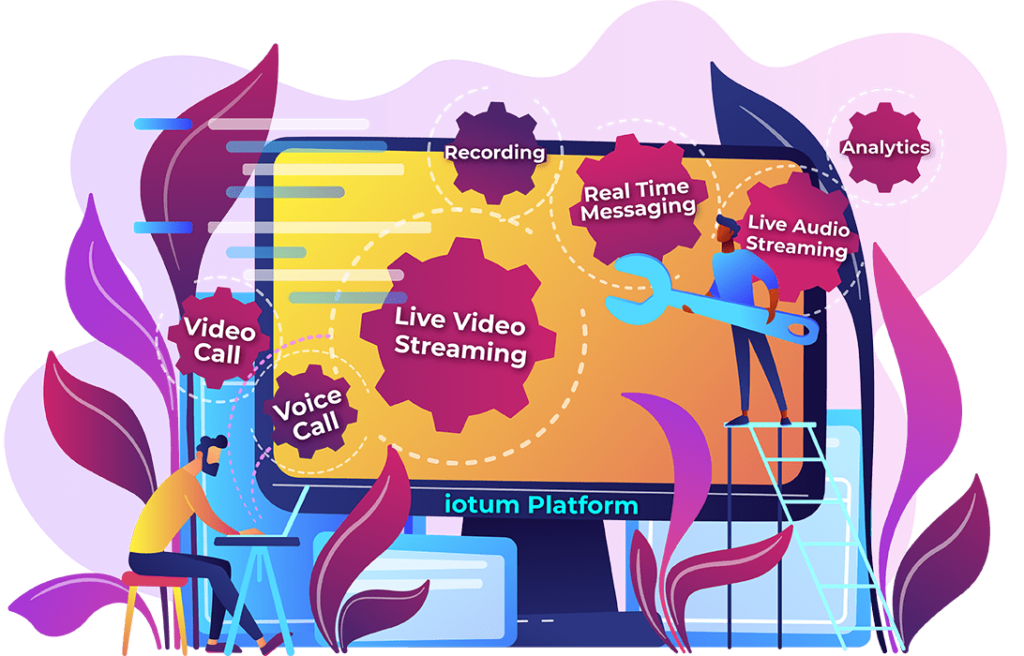 Millions of people around the world are seeing the benefits of making the shift to online therapy for mental health treatment.
Millions of people around the world are seeing the benefits of making the shift to online therapy for mental health treatment.
What works in real life – an open dialogue between a patient seeking professional help and a licensed professional who can offer it – is now available online with video conferencing technology. People are resorting to online counseling and therapy for the effective treatments of depression, addiction, anxiety, relationship problems, mental health disorders and so much more as a way to heal, face their trauma and get answers.
The use of technology (otherwise known as telemedicine) has blown open the rate and convenience of therapeutic care for patients by way of overall feasibility including accessibility, cost, opportunity, and a myriad of other factors – especially with video conferencing that’s HIPAA compliant.
Let’s get a closer look at how video conferencing plays a pivotal role for mental health professionals and their patients, by providing the best video conferencing app to support their journey.
How Do Psychologists Treat Patients?
In the physical world, psychological treatment is done face to face in a clinical setting. Professionals are sought after by patients looking to:
- Gain a more in depth understanding of their thought process, trauma and behavior
- Resolve problems on their own
- Identify mental health disorders and illnesses
- Reprogram behavior
- Mitigate symptoms
- Acquire the tools and coping mechanisms to improve the quality of their life
One of the main draws of being under the care of a psychologist is that they encourage a safe space for two-way communication to transpire. Through active communication, and a feedback loop in a controlled environment, psychologists can help patients navigate the triggers and negative states of being that affect their day to day.
The basis of any healthy psychologist-patient relationship is through communication that breaks through walls to:
- Create strategies that work to develop healthier behavior
- Provide goals that measure progress
- Build better communication and problem solving skills
- Manage and streamline intense feelings and unhealthy thinking
- Cope with stressors and anxiety
Support patients through life changing events (death, job loss, bankruptcy, etc)
With video conferencing and free video conferencing software at the forefront of how people communicate, it’s not surprising how online therapy is an expanding field. While every patient should weigh the pros and cons of seeking medical help online, more and more, the implementation of video used as a therapeutic tool is developing rapidly.
Telemedicine is a video conferencing software solution that works to bridge the gap between practitioners and patients.
Even more specifically, telepsychology (or cyber-psychology) opens the lines of communication for patients to be put in touch with a psychologist for a conference call or video chat, independent of geographic location. While the software is very helpful with initial appointments, diagnostics, follow-ups and prescriptions, the technology can be exceedingly beneficial as an online therapy platform.
 Psychologists, psychotherapists, counselors, clinicians, health and wellness experts and more can all shift their practice (or parts of their practice) online to provide patient care and treatment in a virtual setting. Psychologists can continue to support patients through addiction and drug abuse, diagnosing and managing autism spectrum disorder, pain and diabetes management, insomnia, anxiety and eating disorders, etc. This can take shape as a one-on-one session, group therapy sessions virtually.
Psychologists, psychotherapists, counselors, clinicians, health and wellness experts and more can all shift their practice (or parts of their practice) online to provide patient care and treatment in a virtual setting. Psychologists can continue to support patients through addiction and drug abuse, diagnosing and managing autism spectrum disorder, pain and diabetes management, insomnia, anxiety and eating disorders, etc. This can take shape as a one-on-one session, group therapy sessions virtually.
How To Treat Your Patients Online
By implementing the use of video in a session, online therapy has the capacity to truly make a difference in the lives of the people who need it. Video conferencing is a direct point of contact that is second best to being in person and works along the same lines as traditional therapy methods.
Video therapy has been proven to be just as effective as sharing space physically in the same room. There was no difference between Cognitive Behavioral Therapy done via video conferencing or in-person for the treatment of depression, anxiety, and stress symptoms.
Furthermore, some clinical psychologists are saying that certain patients prefer seeing their healthcare providers via telehealth and video therapy sessions. If a patient requires specific treatment from a specialized provider, video opens up the possibility for professionals to work with patients regardless of proximity.
In an article from the American Psychologist Association, two clinical psychologists, Dennis Freeman, PhD., and Patricia Arena, PhD, weigh in with a few key points about providing therapy online:
- It Saves Time
Video conferencing affords the psychologist and client the opportunity to meet in a virtual setting without driving, parking, commuting and wasting time getting to the far reaches of a rural area or the maze of a city. - Patients from all over can receive treatment from the professional they need, regardless of location. “It would probably take about four hours to drive across our service area, so we’re always looking for strategies to get services to our patients,” says Freeman.
- It’s Immediate And Versatile
Online therapy sessions can be scheduled ahead of time or in the case of an emergency, an on-the-fly meeting can happen immediately. If a patient is in the throes of a crisis or if a psychologist needs to facilitate a voluntary hospitalization, it can be done via video conferencing. “I’ve really dealt with the full range of situations just as effectively via telemedicine,” says Arena. - It Can Feel Just As Close To Being In Person
An online therapy session provides the same amount of facetime as an in person session. With the right home or office set-up, and video conferencing technology, Arena says, “I’ve found it to be really no different than talking to them face-to-face.” - It Can Be Just As Effective
While there might be a slight transition and feel unfamiliar to sink into at first, all it takes is a bit of warming up. By making your surroundings comfortable and approaching the session with an open mind, it’s easy to make progress and settle in comfortably. “Initially, they say it’s a little strange and takes some getting used to, but after a few minutes, both established and new clients have commented on the fact that they completely forget that they’re talking to a TV,” says Arena - It Opens Up Possibilities And Closes The Gap
Video conferencing for psychologists makes connecting to clients not only easier, and more affordable but also broadens the reach across a network. Offering support is user-friendly, practical and manageable for all segments of the population including those living with physical and psychological disabilities. “We have such a maldistribution of psychologists and other mental health professionals in this country, and this opens up real opportunities to work with these populations even if you don’t live in close proximity to them,” says Freeman.
 A key tool in every psychologist’s tool box is Cognitive Behavioral Therapy. When applying these techniques in an online setting, psychologists can now support patients with Internet-based Cognitive Behavioral Therapies (ICBT). ICBT is a loose term that refers to an online platform available to both the patient and professional to gain and offer support virtually.
A key tool in every psychologist’s tool box is Cognitive Behavioral Therapy. When applying these techniques in an online setting, psychologists can now support patients with Internet-based Cognitive Behavioral Therapies (ICBT). ICBT is a loose term that refers to an online platform available to both the patient and professional to gain and offer support virtually.
ICBT programs and offerings may differ, but typically, the procedure consists of:
- An online assessment through a virtual questionnaire
- A video conference or conference call with a psychologist
- Online modules to complete at the patient’s pace
- Tracing and monitoring patient progress
- Check-ins along the way by phone, video or messaging
Here are a few of the many ways psychologists can use online therapies including ICBT to offer support for:
Panic Disorder:
According to a 2010 study discussing internet treatment for panic disorders; ICBT with a focus on video conferencing, works to provide more face time through virtual 1:1 consultations and is just as effective as face-to-face therapy.
Depression:
In a 2014 study, Internet-based depression therapy was pitted against in-person, face-to-face therapy using cognitive-behavioral therapy principles and feedback through text. The study showed that internet-based intervention for depression is just as beneficial to the more traditional mode of therapy.
Anxiety And Stress:
Mobile phone and web-based intervention apps have been designed as an interactive self-help program to assist in managing varying degrees of stress, anxiety and depression. These low-cost “mobile mental health programs” are showing promising results amongst young people.
Schizophrenia:
Telephone and texting interventions work to ensure patients are taking their medication in a timely manner.
ICBT and forms of online therapeutic treatment can be very helpful when dealing with other health conditions such as diabetes management, health promotion for wellness and weight loss, smoking cessation and so much more.
What Are The Advantages Psychologists Can Experience With Video Conferencing?
With video therapy solutions at the fingertips of psychologists, video conferencing has transformed the interaction to become more effective for patients and more successful for professionals.
Consider the following benefits for psychologists who treat clients virtually:
- A More Inclusive Healthcare Delivery Model
By existing in an online space, psychologists can provide more convenient and direct care for patients. Open lines of communication mean geographical barriers are broken down to accommodate patients who require psychological attention, irrelevant of physical location. Accessibility to treatment and digital technology that lessens travel and cuts time provides better mental health services for all clients. - Extended Reachability For Patients
Obtaining an appointment with a niche medical specialist or specific hospital system; or keeping up with sessions amidst a pandemic or busier-than-usual time period is not ideal for many patients suffering with a condition. Telemedicine, consisting of video conferencing consults, puts patients directly in front of the medical professional they need in less time. This also saves time in the day for the professional. Consider how a small hospital without adequate technology can expedite processes by outsourcing x-rays and CT scans; or safely transfer files with other practices, to transfer patients or apply for a second opinion. - Enhanced Psychologist-Patient Relationships
Empower patients to manage their care by nurturing the relationship with video therapy that:- Fosters a level of comfort where patients can feel safe and secure in their own space
- Connect more frequently across different channels:
- Video: For longer 1:1 sessions
- Phone calls: For updates and information gathering
- Text chat: For check ins, support and follow ups
- Less Demanding Healthcare Costs
Depending on location, insurance coverage and severity of a patient’s condition, there are many factors that determine the cost of healthcare expenditure. Telemedicine has the capacity to save unnecessary sunken costs, reducing problems such as:- Non-critical ER visits
- More efficient doctor visits
- Virtual prescriptions
- Medication non-adherence
- Follow-ups, diagnostics, and more
- More Patient-Centric Approaches
Timeliness helps to provide crisis management and intervention by making it convenient for psychologists to check in and assess how a patient is coping. More enhanced options offer systems to monitor a patient’s bodily functions such as heart rate or sleep, while another approach is to conduct regular video chats after a patient has been discharged or if he/she requires follow-up support. - Provide Professional and Confidential Care
At the forefront of creating or using video conferencing as an online therapy platform is patient confidentiality. Ensure files and documents are safeguarded, and video chats are kept private with 180bit end to end encryption. Other features such as meeting lock and one-time access code work to provide a safe online setting for cyber-psychotherapy.
How Video Conferencing Helps Psychologists
If your practice has mostly been conducted in a physical setting, now is the time to bring it online. Video conferencing helps psychologists to:
- Provide more customized care
- Be connected to a larger network of qualified professionals
- Improve the user experience for patients by becoming more convenient, affordable and accessible
- Find clients that match your offerings
- Showcase and market your credentials, education, experience and list of services
- And so much more
Let FreeConference.com open you up to the possibilities of helping more people and expanding your practice in a virtual setting with a free video-conferencing platform that can get you there.
Like other HIPAA compliant teletherapy platforms, FreeConference.com works to protect and secure your practice.
FreeConference.com comes with the features designed to make your video therapy sessions run smoothly and efficiently by allowing your patients to feel seen and heard. Become even more accessible with FreeConference.com; the best free video conferencing app that’s compatible on Android and iPhone.


